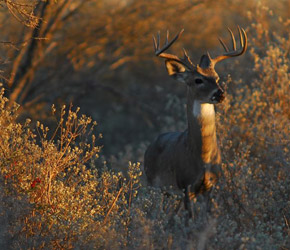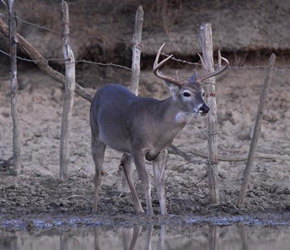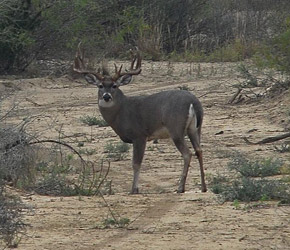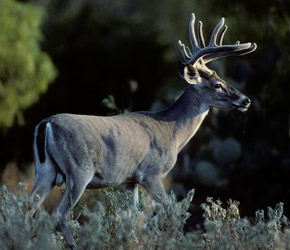White-tail deer are the most abundant large game species in North America; the whitetail population is largest in Texas, where an estimated three to four million of the deer reside. Their characteristic tails are held erect when fleeing to display the white underside; the rest of their body is reddish-brown in summer and grayish-brown in winter. Fawns less than six months of age have bright white spots scattered on their coats. Adult bucks can attain lengths of over six feet and weight up to three hundred pounds; adult does tend to be smaller.
Population: Estimated 29 million in the U.S. and 3.6 million in Texas
Range: A deer’s home range is usually less than a square mile
Size: 6 ft. to 7.75 ft. in length. Weight: 100 – 300 lbs.
Vision: The deer’s eyes are located on the sides of its head, giving 310 degrees of vision without moving. With the positioning of the eyes it is hard to focus on objects.
Speed: A deer can reach speeds of 30 - 40 mph and jump fences up to 9 feet tall. A deer can leap as far as 25 – 30 feet.
Swimming: Deer can swim at speeds up to 13 mph
Sense of Smell: Deer can detect odors several hundred yards away and
Aging Deer Criteria
Yearlings: 1.5-year-old bucks

At this age, a buck looks like a doe with antlers. There will usually be a slight dip in the back. They have a thin neck, no defined brisket, white tarsal glands, and the belly line has a distinct up turn near the hams. This gives it a greyhound racing dog sort of look. The legs still look very long, and the gait is still pretty frisky. They will make unwanted sexual advances on does, but are very timid in the presence of older bucks.
1.5 year old bucks can be described as a doe with antlers; a very thin neck and long and thin legs.
2.5-year-old bucks

At two and a half, the animal starts bulking up a tad, but just a tad. The neck will be bigger than a doe or yearling buck, but not much. The legs still look fairly long. The face looks long and the skin tight. Eyes are near perfectly round. Slightly developed brisket. The belly still has somewhat of an upturn near the hams. The tarsal gland may have some color to it. The rump appears squared off.
2.5 year old bucks' antlers are not large, but will attract your attention. Their legs still remain long in proportion to the rest of their body.
3.5-year-old bucks

A three and a half year old buck is usually very lean muscle, and act ready for action. They may make rubs and scrapes if no bigger bucks are present. The nose lengthens and broadens, the head will look as long as it's going to look during their life. Eyes are still very round. The brisket is noticeable but not pronounced. Legs look the right length now. The belly line is flat, with just a little up turn at the rear. The tarsal gland will be dark in rut. Rump starts looking more rounded at times and squared off at times, depending on stance. Back line is flat.
3.5 year old bucks, or middle-aged bucks, can be compared to a well-conditioned race horse with a distinct junction between their neck and shoulder.
4.5-year-old bucks

If fed well, a 4 and a half year old buck really starts looking like a buck. The give aways now are the back and belly lines, and the head. On level ground, the back will have a slight dip only, and the belly will not hang below the chest line. The head skin will not look tight or loose, and the eyes aren't quite round anymore. When one of these bucks walk, they still pick their feet up pretty good, and the front knees won't look bent in when the deer is walking toward you. Rump is getting pretty round, and tarsal glands will be black when near or in rut. Non-typical points may start to show up now.
4.5 year old bucks have an obvious junction between the neck and shoulders dissipates as the neck becomes firmly muscled.
5.5-year-old bucks

At five and a half, the eye will obviously not be round any more, it starts to look squinty. The principal characteristic defining this age class is a slight sag in the stomach and a slight drop in the back and the brisket is obvious where it joins the neck. They start walking a bit knock kneed and seem more deliberate in their actions. Skin on the head starts looking a bit loose. During the rut their necks are extremely muscled, inflated-like in appearance, eliminating the juncture between the chest and neck.
Five-year-olds are in peak muscular condition with little sign of aging. The tarsals on some become obviously chocolate brown to wet-black, oftentimes extending down the entire inside of their legs.
5.5 year old bucks are approaching their maximum antler size.
6.5-year-old bucks

At six, their physical appearance is similar to five-year-olds; however, one distinguishing feature to look for is obvious loose skin protruding from under the lower jaw. A prominent rounded belly and a sagging back also become obvious. The front knees bend in to handle the weight of the neck and rack. When relaxed, the ears tend to droop down a bit. The Rump is well rounded, the brisket obvious.
Although deer develop their largest antlers at six years of age in South Texas, it doesn’t mean that all six-year-olds will exhibit extremely large antlers because of variable factors such as weather conditions (rainfall) and the animal’s genetic potential, which ultimately determine antler size.
6.5 year old bucks appear physically the same as 5.5 year old bucks, but can be identified by loose skin protruding under their lower jaw.
Field Aging information obtained from: http://www.agingdeer.com/ and http://www.1atexasdeerhunting.com/bodyagingdeer.htm
